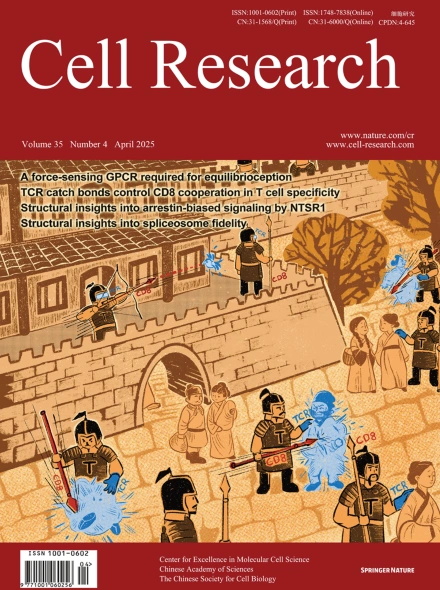
Advanced Search
Submit Manuscript
Advanced Search
Submit Manuscript
Volume 35, No 4, Apr 2025
ISSN: 1001-0602
EISSN: 1748-7838 2018
impact factor 17.848*
(Clarivate Analytics, 2019)
Volume 35 Issue 4, April 2025: 265-283 |
TCR catch bonds nonlinearly control CD8 cooperation to shape T cell specificity
Rui Qin1,† , Yong Zhang2,3,† , Jiawei Shi4,† , Peng Wu5,† , Chenyi An6 , Zhenhai Li7 , Nuo Liu8,9 , Ziyan Wan8,9 , Ting Hua8,9 , Xiaolong Li8,9 , Jizhong Lou2,3,* , Weiwei Yin4,* , Wei Chen1,10,11,*
1Department of Cardiology of the Second Affiliated Hospital and Department of Cell Biology, Zhejiang University School of Medicine, Liangzhu Laboratory, Zhejiang University, Hangzhou, Zhejiang, ChinaNaturally evolved T-cell receptors (TCRs) exhibit remarkably high specificity in discriminating non-self antigens from self-antigens under dynamic biomechanical modulation. In contrast, engineered high-affinity TCRs often lose this specificity, leading to cross-reactivity with self-antigens and off-target toxicity. The underlying mechanism for this difference remains unclear. Our study reveals that natural TCRs exploit mechanical force to form optimal catch bonds with their cognate antigens. This process relies on a mechanically flexible TCR–pMHC binding interface, which enables force-enhanced CD8 coreceptor binding to MHC-α1α2 domains through sequential conformational changes induced by force in both the MHC and CD8. Conversely, engineered high-affinity TCRs create rigid, tightly bound interfaces with cognate pMHCs of their parental TCRs. This rigidity prevents the force-induced conformational changes necessary for optimal catch-bond formation. Paradoxically, these high-affinity TCRs can form moderate catch bonds with non-stimulatory pMHCs of their parental TCRs, leading to off-target cross-reactivity and reduced specificity. We have also developed comprehensive force-dependent TCR–pMHC kinetics-function maps capable of distinguishing functional and non-functional TCR–pMHC pairs and identifying toxic, cross-reactive TCRs. These findings elucidate the mechano-chemical basis of the specificity of natural TCRs and highlight the critical role of CD8 in targeting cognate antigens. This work provides valuable insights for engineering TCRs with enhanced specificity and potency against non-self antigens, particularly for applications in cancer immunotherapy and infectious disease treatment, while minimizing the risk of self-antigen cross-reactivity.
https://doi.org/10.1038/s41422-025-01077-9